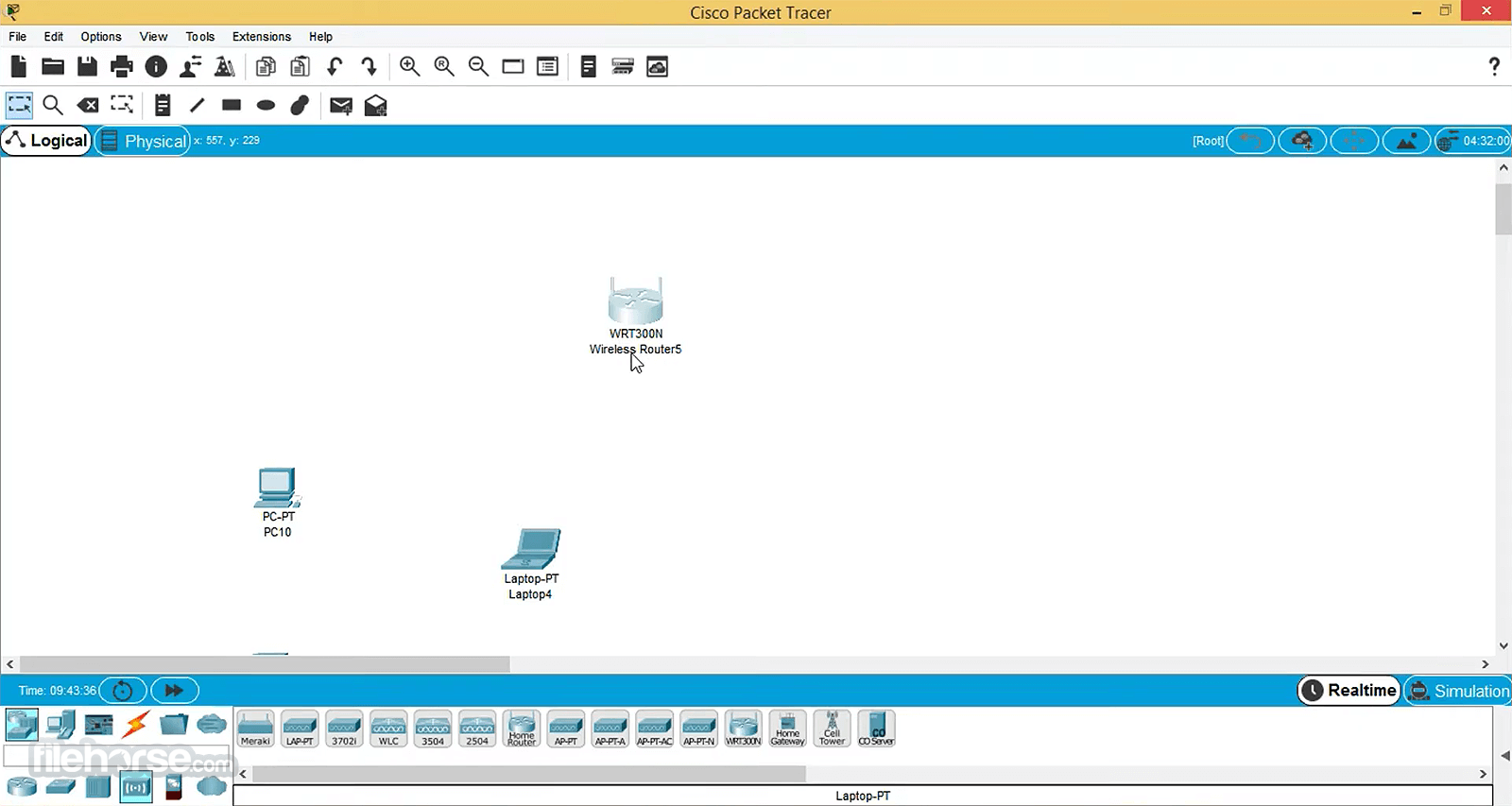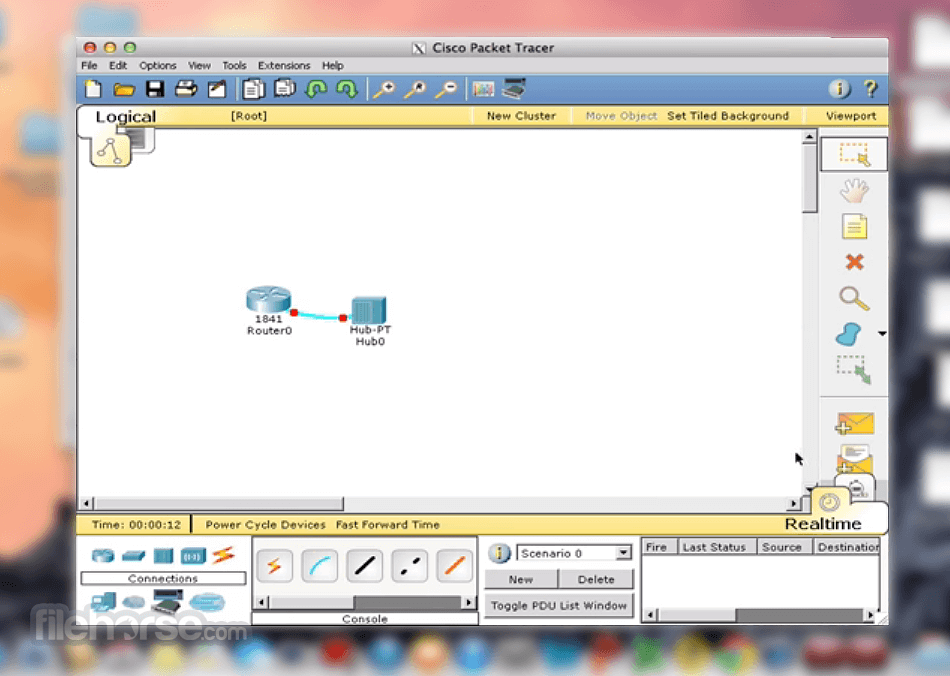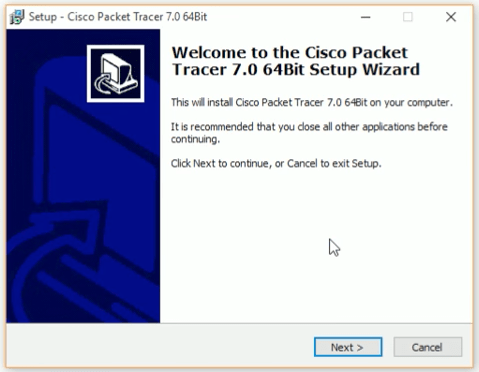Packet Tracer – Identify MAC and IP Addresses
- Cisco Packet Tracer For Mac Free Download
- Cisco Packet Tracer For Mac Os Sierra
- Cisco Packet Tracer Download For Windows 10
Cisco Packet Tracer 7.3.0 torrent download link for Windows 64 bits & 32 bits, MAC, and Linux 64 bits Packet Tracer 7.2.2 (Previous Version) Cisco Packet Tracer 7.2.2 download link for Windows (10, 8.1, 7.0) 64 bits edition. They are pre-configured on the PC's in Packet Tracer. For example, add a PC to your topology and then double click on it. A window will come up and then click on the second tab option that says 'Config'.Then under Interface on the left click on 'FastEthernet'.Once there you can see the duplex and speed settings for that PC, in addition to the MAC Address and IP configuration information.
Objectives
- Part 1: Gather PDU Information for Local Network Communication
- Part 2: Gather PDU Information for Remote Network Communication
Objectives
- This activity is optimized for viewing PDUs. The devices are already configured. You will gather PDU information in simulation mode and answer a series of questions about the data you collect.
Instructions
Part 1: Gather PDU Information for Local Network Communication

- Note: Review the Reflection Questions in Part 3 before proceeding with Part 1. It will give you an idea of the type of information you will need to gather.
Step 1: Gather PDU information as a packet travels from 172.16.31.5 to 172.16.31.2.
- Click 172.16.31.5 and open the Command Prompt.
- Enter the ping 172.16.31.2command.
- Switch to simulation mode and repeat the ping 172.16.31.2command. A PDU appears next to 172.16.31.5.
- Click the PDU and note the following information from the OSI Model and Outbound PDU Layer tabs:
- Destination MAC Address: 000C:85CC:1DA7
- Source MAC Address: 00D0:D311:C788
- Source IP Address: 172.16.31.5
- Destination IP Address: 172.16.31.2
- At Device: 172.16.31.5
- Click Capture / Forward (the right arrow followed by a vertical bar) to move the PDU to the next device. Gather the same information from Step 1d. Repeat this process until the PDU reaches its destination. Record the PDU information you gathered into a spreadsheet using a format like the table shown below:
Example Spreadsheet Format
At Device | Dest. MAC | Src MAC | Src IPv4 | Dest IPv4 |
172.16.31.5 | 000C:85CC:1DA7 | 00D0:D311:C788 | 172.16.31.5 | 172.16.31.2 |
Switch1 | 000C:85CC:1DA7 | 00D0:D311:C788 | N/A | N/A |
Hub | N/A | N/A | N/A | N/A |
172.16.31.2 | 00D0:D311:C788 | 000C:85CC:1DA7 | 172.16.31.2 | 172.16.31.5 |
Step 2: Gather additional PDU information from other pings.
- Repeat the process in Step 1 and gather the information for the following tests:
- Ping 172.16.31.2 from 172.16.31.3.
- Ping 172.16.31.4 from 172.16.31.5.
- Return to Realtime mode.
Part 2: Gather PDU Information for Remote Network Communication
- In order to communicate with remote networks, a gateway device is necessary. Study the process that takes place to communicate with devices on the remote network. Pay close attention to the MAC addresses used.
Step 1: Gather PDU information as a packet travels from 172.16.31.5 to 10.10.10.2.
- Click172.16.31.5 and open the Command Prompt.
- Enter the ping 10.10.10.2command.
- Switch to simulation mode and repeat the ping 10.10.10.2command. A PDU appears next to 172.16.31.5.
- Click the PDU and note the following information from the Outbound PDU Layer tab:
- Destination MAC Address:00D0:BA8E:741A
- Source MAC Address: 00D0:D311:C788
- Source IP Address: 172.16.31.5
- Destination IP Address: 10.10.10.2
- At Device: 172.16.31.5
What device has the destination MAC that is shown?
The router
- Click Capture / Forward (the right arrow followed by a vertical bar) to move the PDU to the next device. Gather the same information from Step 1d. Repeat this process until the PDU reaches its destination. Record the PDU information you gathered from pinging 172.16.31.5 to 10.10.10.2 into a spreadsheet using a format like the sample table shown below:

At Device | Dest. MAC | Src MAC | Src IPv4 | Dest IPv4 |
172.16.31.5 | 00D0:BA8E:741A | 00D0:D311:C788 | 172.16.31.5 | 10.10.10.2 |
Switch1 | 00D0:BA8E:741A | 00D0:D311:C788 | N/A | N/A Sony acid pro mac os x. |
Router | 0060:2F84:4AB6 | 00D0:588C:2401 | 172.16.31.5 | 10.10.10.2 |
Switch0 | 0060:2F84:4AB6 | 00D0:588C:2401 Excel visual basic macro tutorial. | N/A | N/A |
Access Point | N/A | N/A | N/A | N/A |
10.10.10.2 | 00D0:588C:2401 | 0060:2F84:4AB6 | 10.10.10.2 | 172.16.31.5 |
Reflection Questions
- Answer the following questions regarding the captured data:
- Were there different types of cables/media used to connect devices?
Yes: copper, fiber, and wireless - Did the cables change the handling of the PDU in any way?
No - Did the Hub lose any of the information that it received
No - What does the Hub do with MAC addresses and IP addresses?
Nothing - Did the wireless Access Point do anything with the information given to it?
Yes. It repackaged it as wireless 802.11 frames. - Was any MAC or IP address lost during the wireless transfer?
No - What was the highest OSI layer that the Hub and Access Point used?
Layer 1 - Did the Hub or Access Point ever replicate a PDU that was rejected with a red “X”?
Yes - When examining the PDU Details tab, which MAC address appeared first, the source or the destination?
Destination - Why would the MAC addresses appear in this order?
A switch can begin forwarding a frame to a known MAC address more quickly if the destination is listed first - Was there a pattern to the MAC addressing in the simulation?
No - Did the switches ever replicate a PDU that was rejected with a red “X”?
No - Every time that the PDU was sent between the 10 network and the 172 network, there was a point where the MAC addresses suddenly changed. Where did that occur?
It occurred at the router - Which device uses MAC addresses that start with 00D0:BA?
The router - What devices did the other MAC addresses belong to?
To the sender and receiver - Did the sending and receiving IPv4 addresses change fields in any of the PDUs?
No - When you follow the reply to a ping, sometimes called a pong, do you see the sending and receiving IPv4 addresses switch?
Yes - What is the pattern to the IPv4 addressing used in this simulation
Each port of a router requires a set of non-overlapping addresses - Why do different IP networks need to be assigned to different ports of a router?
The function of a router is to inter-connect different IP networks. - If this simulation was configured with IPv6 instead of IPv4, what would be different?
The IPv4 addresses would be replaced with IPv6 addresses, but everything else would be the same.
This article provides direct downloading links of the Cisco Packet Tracer. Download the latest version (7.3.1) as well as all previous versions of the Packet Tracer.
Earlier, the downloading of the packet tracer was restricted. Only students who were enrolled in Cisco Academy courses were allowed to download the packet tracer. This policy was later changed. Now, anyone can download the packet tracer from Cisco’s official site.
The official site of Cisco offers only the most recent versions of Packet Tracer for downloading. You cannot download older versions of the packet tracer from there. The packet tracer is improved in each version, a practice lab created in one version may or may not work in another version. If you do not have a practice lab built in an earlier version or have just started learning from scratch, you may consider downloading the latest version of Packet Tracer from Cisco's official website.
If you are in a hurry or do not wish to register in Cisco Academy courses or looking an earlier version of the packet tracer or for any other reason searching an alternative method to download the packet tracer, then the following section is exactly what you need.

It offers direct download links of the Cisco Packet Tracer for all versions (7.3.1, 7.3.0, 7.2.2, 7.2.1, 7.2.0, 7.1.1, 7.1.0, 7.0, 6.3, 5.0 & 4.0), platforms (Linux, Windows, Android, and MAC), and editions (32bits & 64bits) with various downloading options (zip, exe, torrent, individual file or all files). Do they have dayz for mac.
Packet Tracer 7.3.1 (Latest Version)
Packet Tracer 7.3.0 (Previous Version)
Packet Tracer 7.2.2 (Previous Version)
Packet Tracer 7.2.1 (Previous Version)
Packet Tracer 7.2.0 (Previous Version)
Packet Tracer 7.1.1 (Previous Version)
Packet Tracer 7.1.0 (Previous Version)
Packet Tracer 7.0.0 (Previous Version)
Cisco Packet Tracer 6.3 (Previous Version)
Packet Tracer 5.0 (Older Version)
Packet Tracer 4.0 (Older Version)
Packet Tracer for MAC OS and Apple (iPhone)
Packet Tracer for Android IOS (Smart Phone)
Cisco Packet Tracer For Mac Free Download
Installing packet tracer
Once the desired version of the packet tracer is downloaded, you can use the following tutorials to learn how to install it on Windows and Linux.
This tutorial explains how to install Cisco Packet Tracer step-by-step on Windows.
This tutorial explains how to install Cisco Packet Tracer on Ubuntu Linux and how to run it from a user's home directory.
A brief introduction of the packet tracer
Packet Tracer is a network simulator software. It simulates networking devices that are used to build CCNA practice labs. An average CCNA lab costs more than $300. A packet tracer cuts this cost by simulating all essential CCNA lab devices.
A simulation-based learning environment helps students and instructors. Students can learn how to configure routers and switches from the command line. Packet Tracer provides visual drag-and-drop problems using virtual networking devices. Instructors can create their own self-evaluated assignments for students or use it to demonstrate networking concepts.
Since Packet Tracer was developed for the CCNA practice lab, it uses small and simplified versions of IOS. If some commands do not work in the packet tracer but work in a real device or work in some advance simulator software such as GNS3, it simply means that those commands are not included in the simplified version of IOS.
Cisco Packet Tracer For Mac Os Sierra
Networking devices available in the packet tracer contain only essential commands and features. If you are preparing for a CCNA level exam, then you do not have to worry about the remaining commands and features. For CCNA level exams, commands and features available in the packet tracer are sufficient.
Cisco Packet Tracer Download For Windows 10
That’s all for this article. If you have any problem in downloading with any version of the packet tracer from this article, please let us know. If you like this article, don't forget to share it with friends through your favorite social network.
